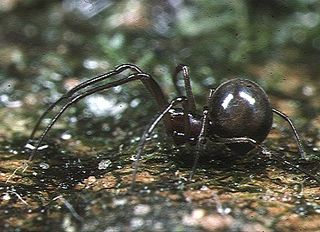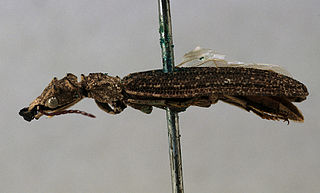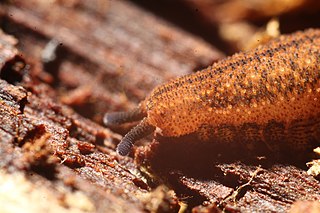
The family Psittacidae or holotropical parrots is one of three families of true parrots. It comprises the 12 species of subfamily Psittacinae and 167 of subfamily Arinae including several species that have gone extinct in recent centuries. Some of the most iconic birds in the world are represented here, such as the blue-and-yellow macaw among the New World parrots and the grey parrot among the Old World parrots.

Pseudoscorpions, also known as false scorpions or book scorpions, are small, scorpion-like arachnids belonging to the order Pseudoscorpiones, also known as Pseudoscorpionida or Chelonethida.

Scott McCloud is an American cartoonist and comics theorist. He is best known for his non-fiction books about comics: Understanding Comics (1993), Reinventing Comics (2000), and Making Comics (2006), all of which also use the medium of comics.

Michael John Harvey is an Australian musician, singer-songwriter, composer, arranger and record producer. A multi-instrumentalist, he is best known for his long-term collaborations with Nick Cave, with whom he formed The Boys Next Door, The Birthday Party and Nick Cave and the Bad Seeds.

Rainbowfishes are small, colourful freshwater fishes belonging to the family Melanotaeniidae, found in northern and eastern Australia, New Guinea, Sulawesi and Madagascar.

Anapidae is a family of rather small spiders with 232 described species in 58 genera. It includes the former family Micropholcommatidae as the subfamily Micropholcommatinae, and the former family Holarchaeidae. Most species are less than 2 millimetres (0.079 in) long.

The Ommatidae are a family of beetles in the suborder Archostemata. The Ommatidae are considered the extant beetle family that has most ancestral characteristics. There are only seven extant species, confined to Australia and South America. However, the geographical distribution was much wider during the Mesozoic spanning across Eurasia and Australia, suggesting that they were widespread on Pangea. So far, over 26 extinct genera containing over 170 species of these beetles have been described. Three extant genera have been assigned to this family: Omma,Tetraphalerus and Beutelius. The family is considered to be a subfamily of Cupedidae by some authors, but have been found to be more closely related to Micromalthidae in molecular phylogenies. A close relationship with Micromalthidae is supported by several morphological characters, including those of the mandibles and male genitalia. Due to their rarity, their ecology is obscure, it is likely that their larvae feed on deadwood.
Pinkfloydia is a genus of small Australian long-jawed orb-weavers, reaching a maximum lengths of about 4.5 millimetres (0.18 in). It was first described by D. Dimitrov & G. Hormiga in 2011, and contains two species, found in New South Wales and Western Australia: P. harveyi and P. rixi. They have a unique rounded, cone-shaped head structure with one pair of large eyes and three pairs of smaller eyes. The genus is named after British rock band Pink Floyd.

Kumbadjena is a genus of velvet worms in the family Peripatopsidae. All species in this genus are ovoviviparous, all have 15 pairs of oncopods (legs), and all are found in the southwest of Western Australia.
Cordylochernes is a genus of pseudoscorpions in the Chernetidae family. It was described in 1932 by Austrian arachnologist Max Beier.
Americhernes is a genus of pseudoscorpions in the Chernetidae family. It was described in 1976 by American arachnologist William Muchmore.
Americhernes muchmorei is a species of pseudoscorpion in the Chernetidae family. It is endemic to Australia. It was described in 1990 by Australian arachnologist Mark Harvey. The specific epithet muchmorei honours American arachnologist William Muchmore (1920–2017) who described the genus Americhernes.
Austinochernes is a genus of pseudoscorpions in the Chernetidae family. It is endemic to Australia, and was described in 2021 by Australian arachnologist Mark Harvey. The genus name honours Professor Andy Austin for his contributions to systematics, combined with the genus name Chernes.
Balgachernes is a monotypic genus of pseudoscorpions in the Chernetidae family. It is endemic to Australia, and was described in 2018 by Australian arachnologist Mark Harvey. The name of the genus combines the common name 'balga' for the grasstree species Xanthorrhoea preissii, with which the pseudoscorpions are associated, with the genus name Chernes.
Barbaraella is a monotypic genus of pseudoscorpions in the Chernetidae family. It is endemic to Australia, and was described in 1995 by Australian arachnologist Mark Harvey.
Satrapanus is a monotypic genus of pseudoscorpions in the Chernetidae family. It is endemic to Australia's Lord Howe Island in the Tasman Sea. It was described in 2007 by Australian arachnologists Mark Harvey and Erich Volschenk. The generic epithet comes from the Latin satrapa with reference to the pseudoscorpion being the only known species of the genus on the island.
Marachernes is a genus of pseudoscorpions in the Chernetidae family. It is endemic to Australia. It was described in 1992 by Australian arachnologist Mark Harvey. The genus name honours Māra Blosfelds for her contributions to the collection of the type species, combined with Chernes, the type genus of the family.
Rugowithius is a genus of pseudoscorpions in the Withiidae family. It is endemic to northern Australia. It was described in 2015 by Australian arachnologist Mark Harvey.
Linnaeolpium is a monotypic genus of pseudoscorpions in the Olpiidae family. It was described in 2008 by Australian arachnologists Mark Harvey and Mei Chen Leng. The genus name Linnaeolpium honours Carl Linnaeus (1707–1778), founder of modern taxonomy, in combination with the generic name Olpium.
Thenmus augustus is a species of pseudoscorpion in the Menthidae family. It is endemic to Australia. It was described in 2006 by Australian arachnologist Mark Harvey. The specific epithet augustus refers to the type locality.







